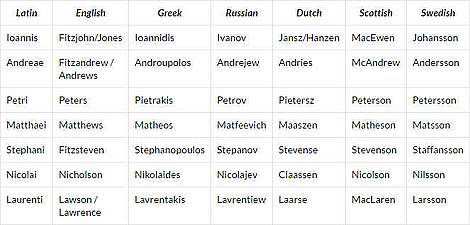By Jorge Lintrup. Article first published at Dalarötter.
One of the most common problems for Swedish-American descendants, who are searching their roots, is to understand the difference between common family names and patronymics. We get questions as ”How can we follow the Peterson family back to the first Peterson?” or ”My great grandfather changed his family name from Andersson to Nilsson”.
The truth is that it is totally impossible to follow surnames as Petersson or Andersson, and that the great grandfather never changed his surname, he only used his patronymic.
The great peasant society that existed just about to the Second World War, had it’s own deeply rooted traditions. One of them was to use patronymics. Other classes had used patronymics before, but certain professions and craftsmen, as well as the nobility, began to use family names as early as in the Middle Ages. So by the 18th century it was only the clergy and the peasants who used patronymics, even though the clergy often latinized their names and patronymics.
It’s rather easy to recognize a patronymic. It always ends with either -son or -dotter, which means son or daughter. Andersson means ”the son of Andrew”, Johansdotter means ”the daughter of John”. In our neighbor countries Norway and Denmark patronymics ends with -sen or -datter, but that is only local varieties of the same thing. Island, Faroe Islands and old time records from Norway and Denmark use the same endings as in Sweden, -son or -dotter.
Not only Scandinavian countries used patronymics. They are still very common in Russia and other Slavonic countries, in Greece, in Arabic countries, etc., and Señor Fernandez in Spain has an old patronymic. On the British Isles patronymics were used by Englishmen, as well as Welsh, Irish and Scots, and surnames as Andrews, Peters, Harrison, McDonald, Dawson, FitzRoy and Jones are all patronymics.
So, Olof’s son Jonas was called Jonas Olofsson, and his son Erik was called Erik Jonasson. Some times patronymics got shortened, so Jonas Olofsson was called Jonas Olsson, and his son Erik was called Erik Jonsson, but that is another problem…
When women married they did not loose their own surnames. That’s a modern invention. In old church records you will find the women wearing their own names, surnames and patronymics all their life. Sometimes they will appear as the wife of somebody, with or without their Christian name, but you will seldom find them wearing their husbands surname, and NEVER wearing their husband’s patronymic.
During the 19:th century patronymics got out of fashion even in the peasant society. Gradually patronymics transformed into what we call surnames. Sons and daughters took their father’s patronymic as their surname, so patronymics became authentic family names. By 1901 the Swedish government passed a new law forcing everyone to take a surname. That was the final vanishing of Swedish patronymics.

